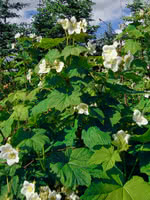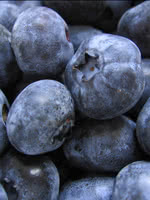Mon-Fri 9am - 5pm Mountain time
Thimbleberry vs Top Hat Blueberry
Rubus parviflorus
Vaccinium x Top Hat
NOT AVAILABLE THIS SEASON - MIGHT RETURN
NOT AVAILABLE THIS SEASON - MIGHT RETURN
Thimbleberry is an ornamental shrub with large, green maple-like-leaves. Flowers are attractive, fragrant, and turn into red-raspberry-like berries. The berries are good for jams, cakes, breads, muffins etc. If you remove the berry, the core resembles a thimble, giving this shrub its namesake.
Top Hat Blueberry is ideal for decks, patios, and small yards. This compact blueberry produces loads of good tasting berries early in the summer. This variety's berries are well suited for baking.
While Top Hat Blueberry is self-pollinating, we recommend pairing it with another suitable blueberry to increase the berry production of both varieties.
We recommend planting Top Hat Blueberry into the ground or into planters that have at least 5 gallons of soil per plant for the best results. Do not plant them into pots (voids your guarantee).
Note: Blueberries require very specific soil conditions. They need well-drained soil with a pH between 4.5 and 5.0. If the starting pH of your soil is between 5.1 and 6.2 you can lower it by adding sulfur. We recommend against planting blueberries in soil with a starting pH greater than 6.2. Please do your own research before buying any blueberry plants.

